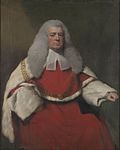Top Qs
Timeline
Chat
Perspective
Chief Justice of the Common Pleas
Archaic position of honour in English common law court From Wikipedia, the free encyclopedia
Remove ads
The chief justice of the common pleas was the head of the Court of Common Pleas, also known as the Common Bench, which was the second-highest common law court in the English legal system until 1875, when it, along with the other two common law courts and the equity and probate courts, became part of the High Court of Justice. As such, the chief justice of the Common Pleas was one of the highest judicial officials in England, behind only the lord high chancellor and the Lord Chief Justice of England, who headed the King's Bench (Queen's when the monarch was female).

Remove ads
History
Initially, the position of chief justice of the common pleas was not an appointment; of the justices serving in the court, one would become more respected than his peers, and was therefore considered the "chief" justice.
The position was formalised in 1272, with the raising of Sir Gilbert of Preston to Chief Justice, and from then on, it was a formally-appointed role, similar to the positions of Lord Chief Justice and Chief Baron of the Exchequer.[1] When the High Court was created in 1875, each of the three common law courts became separate divisions of it, each headed by the person who had led the respective court before the merger.
When the Lord Chief Justice and Chief Baron died in 1880, the three common law divisions (Queen's Bench, Exchequer, and Common Pleas) were merged, and John Coleridge, the Chief Justice of the Common Pleas, became Lord Chief Justice, and the offices of Chief Justice of the Common Pleas and Chief Baron were abolished.[2]
Remove ads
Chief justices of the common pleas
- Sir Edward Coke, a famed jurist whose judgements included seminal cases in corporate and competition law and the creation of judicial review
- Sir Orlando Bridgeman, who tried the Regicides of Charles I
- Sir Nicholas Conyngham Tindal, who successfully defended Queen Caroline on charges of adultery in 1820
- Sir Alexander Cockburn, who was repeatedly refused a peerage on the grounds of "notoriously bad moral character"
Remove ads
Peerages created for the lord chief justice of the common pleas
Legacy
A Wetherspoon pub in Keswick, Cumbria is named "The Chief Justice of the Common Pleas", this is due to the current building constructed in 1901 been built on land which was formally the site of a ‘workhouse’ - founded in the will (dated 1642) of Sir John Bankes. The current building which housed the towns magistrates’ court and police station until the year 2000, was built next to the towns main post office itself constructed ten years earlier around 1890. [4]
Remove ads
References
Bibliography
Wikiwand - on
Seamless Wikipedia browsing. On steroids.
Remove ads












































